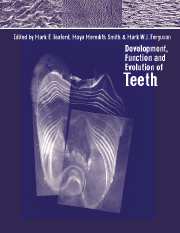Book contents
- Frontmatter
- Contents
- List of contributors
- Acknowledgements
- Part one Genes, molecules and tooth initiation
- Part two Tooth tissues: development and evolution
- Part three Evolution of tooth shape and dentition
- Part four Macrostructure and function
- 16 Developmental plasticity in the dentition of a heterodont polyphyodont fish species
- 17 Enamel microporosity and its functional implications
- 18 Pathways to functional differentiation in mammalian enamel
- 19 Trends in the evolution of molar crown types in ungulate mammals: evidence from the northern hemisphere
- 20 Function of postcanine tooth crown shape in mammals
- 21 Primate dental functional morphology revisited
- Index
21 - Primate dental functional morphology revisited
Published online by Cambridge University Press: 11 September 2009
- Frontmatter
- Contents
- List of contributors
- Acknowledgements
- Part one Genes, molecules and tooth initiation
- Part two Tooth tissues: development and evolution
- Part three Evolution of tooth shape and dentition
- Part four Macrostructure and function
- 16 Developmental plasticity in the dentition of a heterodont polyphyodont fish species
- 17 Enamel microporosity and its functional implications
- 18 Pathways to functional differentiation in mammalian enamel
- 19 Trends in the evolution of molar crown types in ungulate mammals: evidence from the northern hemisphere
- 20 Function of postcanine tooth crown shape in mammals
- 21 Primate dental functional morphology revisited
- Index
Summary
We will never understand organisms without an integrative approach
Schmidt-Kittler and Vogel, 1990Introduction
It is no secret that over the past 20 years there has been a veritable explosion of information generated by scientific research. One of the beneficiaries of this information explosion has been the study of morphology, where new techniques and analyses have led to new insights into a wide range of topics. Teeth have been no exception to this, as advances in genetics, histology, microstructure, biomechanics, microscopy, and morphometrics have allowed researchers to study teeth from new perspectives. For instance, advances in genetics and histology have given researchers a much clearer perspective on the embryological origins of tooth morphology, as we now move from correlations between multiple gene expression patterns (see Chapter 11) to an understanding of very specific cause-and-effect relationships between genes and tooth cusp formation (Chapters 1 and 2). As another example, work by Chris Dean, David Beynon, and others has shown that variations in dental microstructure can be related to periodic fluctuations in tooth development which can, in turn, lead to new insights into the growth and development of our ancestors (see Chapter 9).
This new range of material requires two changes in perspective by all parties involved. First, given the technical complexities of many of the new approaches, communication and collaboration are the keys to the future. In short, we must work together if we are to successfully harness the techniques available to us. Second, in doing so, we will have no choice but to broaden our perspectives of “dental functional morphology’.
- Type
- Chapter
- Information
- Development, Function and Evolution of Teeth , pp. 290 - 304Publisher: Cambridge University PressPrint publication year: 2000
- 13
- Cited by



